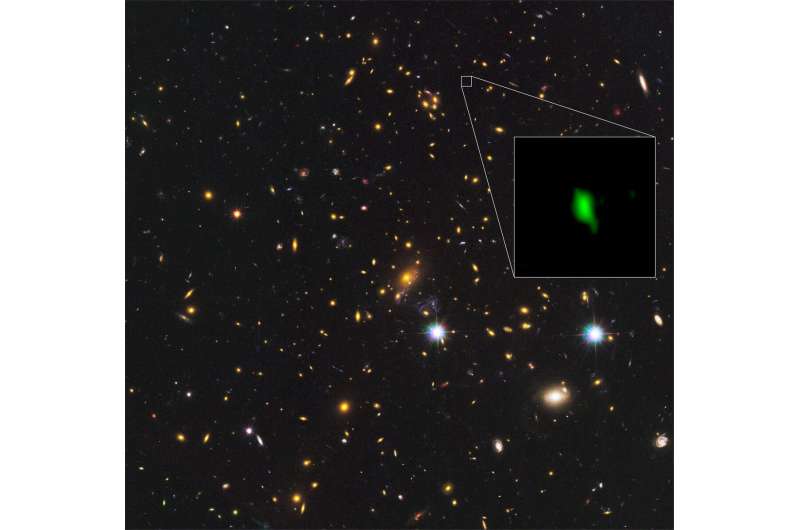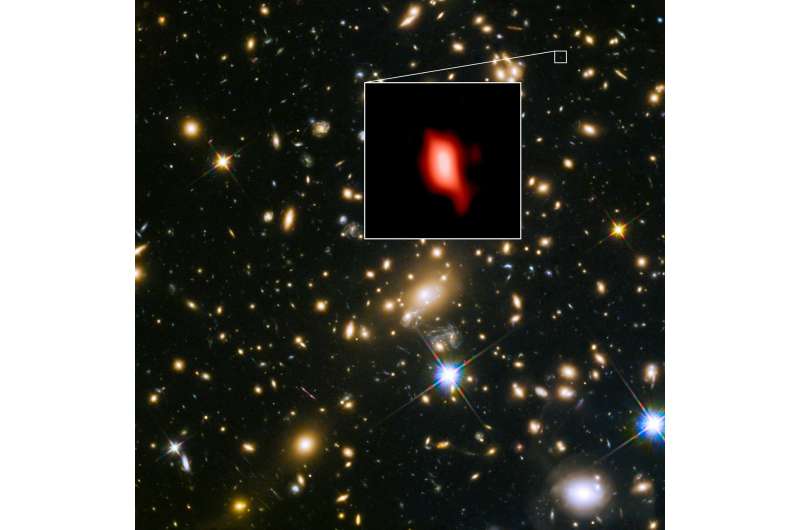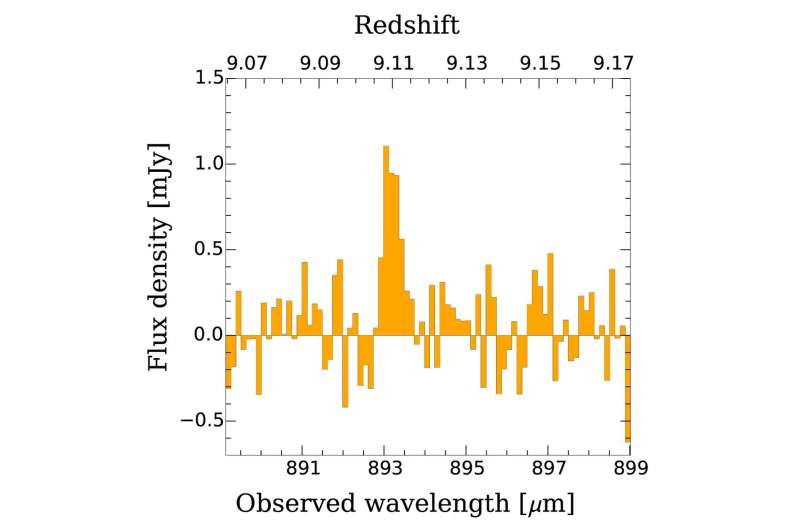Astronomers find evidence for stars forming just 250 million years after Big Bang

Not long after the Big Bang, the first generations of stars began altering the chemical make-up of primitive galaxies, slowly enriching the interstellar medium with basic elements such as oxygen, carbon, and nitrogen. Finding the earliest traces of these common elements would shed important light on the chemical evolution of galaxies, including our own.
New observations with the Atacama Large Millimeter/submillimeter Array (ALMA) reveal the faint, telltale signature of oxygen coming from a galaxy at a record-setting distance of 13.28 billion light-years from Earth, meaning we are observing this object it as it appeared when the universe was only 500 million years old, or less than 4 percent its current age.
For such a young galaxy, known as MACS1149-JD1, to contain detectable traces of oxygen, it must have begun forging stars even earlier: a scant 250 million years after the Big Bang. This is exceptionally early in the history of the universe and suggests that rich chemical environments evolved quickly.
"I was thrilled to see the signal of the most distant oxygen," explains Takuya Hashimoto, the lead author of the research paper published in the journal Nature and a researcher at Osaka Sangyo University and the National Astronomical Observatory of Japan.
"This extremely distant, extremely young galaxy has a remarkable chemical maturity to it," said Wei Zheng, an astronomer at Johns Hopkins University in Baltimore, who led the discovery of this galaxy with the Hubble Space Telescope and estimated its distance. He also is a member of the ALMA research team. "It is truly remarkable that ALMA detected an emission line—the fingerprint of a particular element—at such a record-breaking distance."

Following the Big Bang, the chemical composition of the universe was starkly limited, with not even a trace of elements like oxygen. It would take several generations of star birth and supernovas to seed the young cosmos with detectable amounts of oxygen, carbon, and other elements forged in the hearts of stars.
After they were liberated from their stellar furnaces by supernovas, these oxygen atoms made their way into interstellar space. There they became superheated and were ionized by the light and radiation from massive stars. These hot, ionized atoms then "glowed" brightly in infrared light. As this light traveled the vast cosmic distances to Earth, it became stretched by the expansion of the universe, eventually changing into the distinct millimeter-wavelength light that ALMA is specifically designed to detect and study.
By measuring the precise change in the wavelength of this light—from infrared to millimeter—the team determined that this telltale signal of oxygen traveled 13.28 billion light-years to reach us, making it the most distant signature of oxygen ever detected by any telescope. This distance estimate was further confirmed by observations of neutral hydrogen in the galaxy by the European Southern Observatory's Very Large Telescope. These observations independently verify that MACS1149-JD1 is the most distant galaxy with a precise distance measurement.
The team then reconstructed the star formation history in the galaxy using infrared data taken with the NASA/ESA Hubble Space Telescope and NASA's Spitzer Space Telescope. The observed brightness of the galaxy is well explained by a model where the onset of star formation was another 250 million years ago. The model indicates that the star formation became inactive after the first stars ignited. It was then revived at the epoch of the ALMA observations: 500 million years after the Big Bang.
The astronomers suggest that the first burst of star formation blew the gas away from the galaxy, which would suppress the star formation for a time. The gas then fell back into the galaxy leading to the second burst of star formation. The massive newborn stars in the second burst ionized the oxygen between the stars; it is those emissions that have been detected with ALMA.

"The mature stellar population in MACS1149-JD1 implies that stars were forming back to even earlier times, beyond what we can currently see with our telescopes. This has very exciting implications for finding 'cosmic dawn' when the first galaxies emerged," adds Nicolas Laporte, a researcher at University College London/Université de Toulouse and a member of the research team.
"I am sure that the future combination of ALMA and the James Webb Space Telescope will play an even greater role in our exploration of the first generation of stars and galaxies," said Zheng.
ALMA has set the record for the most distant oxygen several times. In 2016, Akio Inoue at Osaka Sangyo University and his colleagues found the signal of oxygen at 13.1 billion light-years away with ALMA. Several months later, Nicolas Laporte of University College London used ALMA to detect oxygen at 13.2 billion light-years away. Now, the two teams merged into one and achieved this new record. This reflects both the competitive and collaborative nature of forefront of scientific research.
"With this discovery we managed to reach the earliest phase of cosmic star formation history," said Hashimoto. "We are eager to find oxygen in even farther parts of the universe and expand the horizon of human knowledge."
This research is presented in a paper "The onset of star formation 250 million years after the Big Bang," by T. Hashimoto et al., to appear in the journal Nature.
More information: The onset of star formation 250 million years after the Big Bang, Nature (2018). nature.com/articles/doi:10.1038/s41586-018-0117-z
Journal information: Nature
Provided by National Radio Astronomy Observatory



















